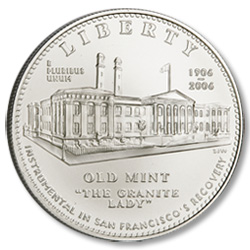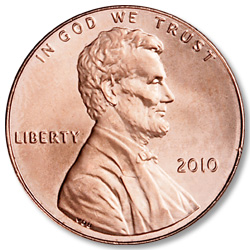Coin Glossaries
Alloy – A mixture of two or more metals.
Assay – To analyze and determine the purity of metal.
Bag Mark – A mark on a coin from contact with other coins in a mint bag.
Bank Note – A form of legalized paper currency issued by a bank.
Bullion – Precious metal in the form of coins, bars, ingots, etc.
Business Strike – A coin intended for circulation (as opposed to a Proof coin specially made for collectors).
Bust – A portrait on a coin, usually including the head, neck and upper shoulders.
Clad Coinage – Coins with a core and outer layer of differing substances. Most modern U.S. dimes, quarters, and half dollars feature a clad composition.
Collar – A metal piece that restrains the expanding metal of a planchet during striking, and creates the 3rd side of a coin (edge).
Commemorative – A coin of special design, issued to honor an outstanding person, place, or event in history.

2006-S San Francisco Old Mint Commemorative Silver Dollar
Condition – The physical state of a coin.
Counterfeit – A coin or piece of currency imitating a genuine article and intended to deceive buyers or users.
Currency – Any medium of exchange including coins, paper money and other items of value used in daily commerce.
Date Collecting – Building a collection of coins containing one issue from each year, regardless of the mint. With date collecting, you can assemble one coin from each year of a particular series, or of a particular denomination.
Date and Mint Mark Collecting – Very popular, and considered by many the most challenging. A date and mint mark collection consists of one coin from each U.S. Mint and each year for a particular series. Many series have a hard-to-find date that can be expensive.
Denomination – The value represented by specific currency, such as a nickel, dime or dollar.
Designer – The artist who creates a coin’s design (but doesn’t necessarily engrave the design into a coinage die).
Device – A symbol or figure on a coin.
Die – A piece of metal bearing the design of the coin. Two dies (front and back) come together against a coin blank to strike a finished coin.
Edge – The outer border of a coin, considered the "third side" of a coin (not to be confused with "rim"). Some coins feature lettering, reeding, or ornamental designs on their edges, formed by the collar.
Encapsulated coin – A coin that has been independently certified and encapsulated in a sonically sealed holder. The holder has a bar-coded identification insert that notes the coin, variety, date and grade.
Engraver – The person who cuts the design into a coinage die (not necessarily the designer)
Error – A coin improperly produced but not detected, and released by the mint.

Adams Presidential Dollar with Overlapped Rim Error
Face Value – The sum for which a coin can be spent or exchanged (a dime’s face value is 10¢), as opposed to its collector or precious metal value.
Field – The portion of a coin’s surface not used for design or inscription.
Fractional Currency – Paper money issued in denominations of 3¢, 5¢, 10¢, 15¢, 25¢ and 50¢ from 1863-1876.
Grade – The condition or amount of wear that a coin has received. The ANA scale measures or grades coins from About Good-3 to Perfect Uncirculated-70.
Hairlines – Minute lines or scratches on coins, usually caused by cleaning or polishing.
Incuse – The design of a coin that has been impressed below the coin’s surface, rather than raised above the surface.
Inscription – The lettering that runs across the fields of a coin.

Inscriptions on a 1999-D Delaware Quarter
Intrinsic Value (melt value) – Refers to the value of the metal in a coin.
Key Date – A scarce date required to complete a collection, usually more difficult to find and afford.
Legal Tender – A coin, note, or other article issued by a government as official money.
Legend – The lettering that circles a coin’s fields just inside its borders.
Medal – A metal object resembling a coin but not of legal tender status.
Mint – A facility that produces coins. Today there are U.S. Mints in Philadelphia, Denver and San Francisco.
Mint Luster – The dull, frosty or satiny shine or finish found on coins, resulting from the centrifugal flow of metal as dies strike the coin blank.
Mint Mark – A small letter that identifies the mint that struck the coin.

The "W" Mint Mark on this 2008-W American Silver Eagle represents the West Point Mint.
Mint Set – Uncirculated set of coins of each denomination from a particular mint.
Mint State – Same as Uncirculated.
Mintage – The quantity of coins produced.
Motto – A phrase or slogan on a coin that is often political or religious, and meaningful to a particular country.
Numismatics – The study and collecting of coins or articles used as money.
Obsolete – A coin design or type that is no longer produced.
Obverse – The front (or "heads") side of a coin, which usually features the date and the principal design.

Obverse of a 2008-D Lincoln Head Cent
Paper Money – Any currency made of paper or similar woven material (U.S. issues include obsolete Silver Certificates and current Federal Reserve Notes).
Pattern – An experimental or trial piece, generally of a new design or metal.
Planchet – The blank piece of metal on which a coin design is stamped.
Proof – A specially produced coin made from highly-polished planchets and dies, and often struck twice to accent the design.
Proof Set – A complete set of Proof coins of every denomination made in a year.
Reeding – A design made up of vertical striations applied to the circumference of the coin’s edge. The product of semi- and fully-automatic coining machines developed in the late 18th century, reeding helps to deter clipping.
Relief – Any part of a design that is raised above the coin’s surface is in relief.
Restrike – A coin minted after the year of its date from the original dies.
Reverse – The back (or "tails") side of a coin.

Reverse of a 2008-D Lincoln Head Cent
Rim – The raised circumference of a coin’s obverse and reverse, circling the design and protecting it from wear (not to be confused with "edge").
Roll – Coins packaged by banks or dealers in quantities: 50 cents, 40 nickels, 50 dimes, 40 quarters, 20 half dollars, 20 dollars.
Series – All dates and mint marks of a specific design and denomination.
Staining – A white to yellow coloration which occurs naturally during the minting process, commonly found on uncirculated silver coins.
Strike – The process of stamping a coin blank with a die bearing the design. A strike may be considered full, average or weak on a particular coin, and will affect the value of rare coins.
Toning – Coloration (patination) caused by chemical reaction to the air or other materials over time.
Type Collecting – Assembling coins on the basis of design instead of by date and mint mark; collecting a coin of each different design in a series.
Uncirculated – Without rub, friction or wear from circulation.
Variety – A minor change from the basic design type of a coin.
Year Set – Collection including at least one coin from each year within a series. May include coins from a single mint, or coins bearing different mint marks.

